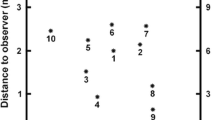Abstract
This paper presents an experimental study of a new algorithm that synthesises separate programs, for fast viewshed, and for fast approximate visibility index determination. It has been implemented in a working testbed for siting multiple observers jointly to cover terrain from a full level-1 DEM, and to do it so quickly that multiple experiments are easily possible. Both the observer and target may be at a given fixed distance above the terrain. The process operates as follows. (1) An approximate visibility index is calculated for each point in the cell under consideration. (2) A set of tentative observers is selected from the highly visible points. (3) The actual observers are selected from them, so as to cover as much of the cell as possible, using a greedy algorithm. Various experiments with varying parameters were performed on the Lake Champlain West cell (raster data set), with observations such as the following. (1) Forcing tentative observers to be well spaced was more important than using the most visible tentative observers. (2) Most of the new observers added (because they covered the most unseen points) were already visible to an existing observer. (3) Randomly deleting many tentative observers before final selection did not reduce the final area covered.
Access this chapter
Tax calculation will be finalised at checkout
Purchases are for personal use only
Preview
Unable to display preview. Download preview PDF.
Similar content being viewed by others
Refrences
Agarwal P, Sharir M (1999) Davenport-Schinzel sequences and their geometric applications. In: Sack JR, Urrutia J (eds) Handbook of Computational Geometry. Elsevier Science Publishers B.V., North-Holland Amsterdam
De Floriani L, Jeanne P, Nagy G (1993) Visibility-related image features. Pattern Recognition Letters 13:463–470
De Floriani L, Magillo P (1994) Visibility algorithms on DTMs. Int. J. Geographic Information Systems 8(1):13–41
Fisher PF (1993) Algorithm and implementation uncertainty in viewshed analysis. Int. J. Geographical Information Systems 7:331–347
Franklin WR (2000) Applications of analytical cartography. Cartography and Geographic Information Systems 27(3):225–237
Franklin WR (2002) Siting observers on terrain — color version [online]. Available from: http://www.ecse.rpi.edu/Homepages/wrf/research/site.pdf
Franklin WR, Ray C (1994) Higher isn’t necessarily better: Visibility algorithms and experiments. In: Waugh TC, Healey RG, (eds) Advances in GIS Research: Sixth International Symposium on Spatial Data Handling. Taylor & Francis, Edinburgh, pp 751–770
Lee J (1992) Visibility dominance and topographic features on digital elevation models. In: Bresnahan P, Corwin E, Cowen D (eds) Proceedings 5th International Symposium on Spatial Data Handling, Vol. 2. International Geographical Union, Commission on GIS, Humanities and Social Sciences Computing Lab, U. South Carolina, Columbia, South Carolina, USA, pp 622–631
Nagy G, Zhang T, Franklin W, Landis E, Nagy E, Keane D (2001) Volume and surface area distributions of cracks in concrete. In: 4th International Workshop on Visual Form. Capri, Italy
Ray CK (1994) Representing Visibility for Siting Problems. Ph.D. thesis, Rensselaer Polytechnic Institute
Shannon RE, Ignizio JP (1971) Minimum altitude visibility diagram — MAVD. Simulation pp 256–260
Shapira A (1990) Visibility and terrain labeling. Master's thesis, Rensselaer Polytechnic Institute
Author information
Authors and Affiliations
Editor information
Editors and Affiliations
Rights and permissions
Copyright information
© 2002 Springer-Verlag Berlin Heidelberg
About this paper
Cite this paper
Franklin, W.R. (2002). Siting Observers on Terrain. In: Richardson, D.E., van Oosterom, P. (eds) Advances in Spatial Data Handling. Springer, Berlin, Heidelberg. https://doi.org/10.1007/978-3-642-56094-1_9
Download citation
DOI: https://doi.org/10.1007/978-3-642-56094-1_9
Publisher Name: Springer, Berlin, Heidelberg
Print ISBN: 978-3-642-62859-7
Online ISBN: 978-3-642-56094-1
eBook Packages: Springer Book Archive




